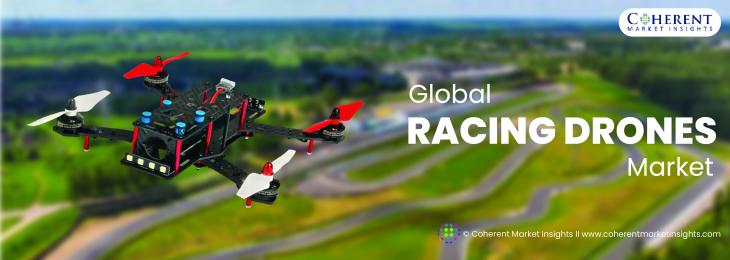
A significant reason fueling the expansion of the drones sector and of racing drones is the demand for lowering human involvement in driving in competitions, which might save expenses and driving time. With this factor, no safety structure needs to be designed or run. A major motivator for the drone/UAV industry as well as for racing drones is the fact that the pilot controls and operates the drones while holding the controller in his hand. This decreases the likelihood of accidents and the loss of human lives.
The market for Racing Drones is anticipated to expand significantly between 2018 and 2026.
Prominent Companies in the Racing Drones Industry:
1. DJI: Created in 2006. Headquarters in Guangdong, China's Shenzhen. Manufacturer of unmanned aerial drones and camera support accessories with the goal of improving the dependability and usability of aerial photography and filming platforms for creators and innovators worldwide. With the help of the company's drones, clients may easily access aerial and handheld cinematic alternatives in the film, agricultural, search and rescue, energy infrastructure, and other industries. The world's largest non-military drone manufacturer, SZ DJI Technology Co Ltd. in China, is in discussions with investors for at least $500 million in fundraising ahead of a scheduled stock market debut, according to people with knowledge of the situation.
2. Parrot: Created in 1994. Located in Paris, France. Parrot SA develops, produces, and sells consumer electronics for tablets and smartphones on a global scale. Consumer drones, including tiny, AR, and bebop models, are available, as well as commercial drones, handsfree kits, plug-and-play devices, and infotainment items. Bluetooth, digital music, and infotainment solutions, as well as audio products and linked devices, are also available.
3. Yuneec: Established in 1999. Headquarters in Germany's Kaltenkirchen. a company that makes remote-controlled aircraft for aerial photography. The company offers a variety of aircraft, including manned aircraft, electric drones, audio-controlled helicopters, micro-copters, camera-supported quadcopters, and hexacopters. This allows users to get a more comprehensive view of the environment and watch live footage of locations from the air.
4. Walkera: Founded in 1994. Head office in China. In order to integrate product research and development, production, marketing, and customer support, a professional aero-model was developed and manufactured. The company creates small, portable aerial models and miniature drones for personal use in a variety of industries, including agriculture, firefighting, measuring land resources, and the energy sector. In 2021, Walker and Associates Inc. was acquired by USTC Corp., Inc., a top value-added distributor of telecommunications supplies and supply chain solutions.
5. Flytec: Launched in 1984. Taiwan is where Eachine's corporate offices are. The design, production, and sale of computers and related accessories are the business activities of Flytech Technology Co Ltd and its affiliates. Geographically, the company is present in Asia, Taiwan, America, Europe, and Africa.
6. Eachine: Eachine creates and develops drones for entertainment. Both quadcopter and fixed-wing drones are part of its product line. Additionally, it sells associated components like FPV gear, propellers, rotors, and batteries. Online purchases of all the products are possible through independent websites like Amazon.
7. RotorX Racing: Founded in 2021. The corporate offices of Eachine are in the US. Manufacturer of unmanned aircraft aiming to provide unmanned aircraft for military, humanitarian, and commercial uses. The Palledrone produced by the company is designed to improve material distribution by reducing workload and delivering supplies on demand. The vehicle can also be equipped with an ISR payload and retransmission capability, which enables aerospace engineers to address logistical issues in the military and electric utility industries.
*Definition: Essentially, a drone is a flying robot that can be remotely controlled or fly autonomously using software-controlled flight plans in its embedded systems, that work in conjunction with onboard sensors and a global positioning system (GPS).





